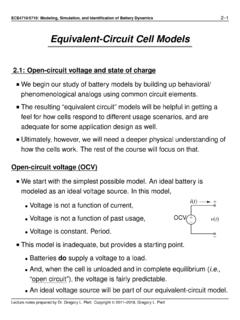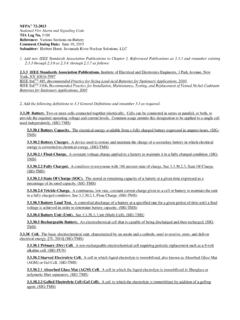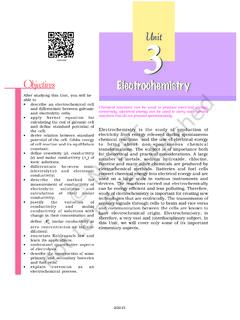Transcription of Fuel Cell Formulary - PEMFC
1 Just anotherFuel Cell Formularyby Dr. Alexander KabzaThis version is from November 9, 2016 and optimized for version see Don t hesitate to send me any comments or failures or ideas byemail!Contents2 Contents1 Thermodynamic of H2/O2electrochemical device .. Nernst equation .. Reactant consumption and feed .. Hydrogen energy and power .. PolCurve (Current voltage dependency) .. Kinetic of the H2/O2electrochemical device .. Butler-Volmer equation .. Example PolCurve .. fuel cell stack power .. fuel cell efficiencies.
2 Different efficiencies .. Electric efficiency calculation .. 232 fuel cell system (FCS) Anode subsystem .. Cathode subsystem .. Cathode pressure controls .. Stack pressure drop .. Cathode air compression .. Coolant subsystem .. fuel cell system efficiency .. FCS electric efficiency .. Auxiliary components .. 34c Alexander KabzaFuel Cell FormularyContents33 Example Stack operating parameters .. 394 Appendix 1: Thermodynamic fundamentals .. Energy and relevant energy units.
3 Temperature dependency of thermodynamic values .. Standard temperature and pressure .. HHV and LHV .. PolCurve parameter variation .. 475 Appendix 2: Constant values and Relevant units based on SI units .. Used abbreviations .. 516 Appendix 3: Moist air .. Water vapor saturation pressure .. Other formulas to express humidity of air .. Energy and power of air .. Air compression .. Definitions .. Thermodynamics .. Ideal and real compressor .. Examples.
4 Comment .. 757 Appendix 4: fuel cell stack water Assumptions .. Derivation .. 768 Appendix 5: FCS controls fuel cell stack pressure drop .. Cathode dynamics - UNDER CONSTRUCTION ** .. 79c Alexander KabzaFuel Cell Formulary41 FundamentalsThis is a collection of relevant formulas, calculations and equationsfor designing a fuel cell system (FCS). Thermodynamic of H2/O2electrochemical deviceIn an H2/O2electrochemical device hydrogen is oxidized by oxygen towater in an exothermic reaction:H2+12O2 H2O(g) rH <0 Thereaction enthalpy rHis equal to theenthalpy of water forma-tion fH.
5 The (chemical) energy content of any fuel is calledheatingvalue(for more information on thermodynamics see chapter ). Theheating value of hydrogen is equal to the absolute value of the reac-tion enthalpy. Because product water is produced either as gaseousor liquid phase, we distinguish between thelower heating value(LHV)and thehigher heating value(HHV) of hydrogen:H2+12O2 H2O(g) fHH2O(g)= LHV = Alexander KabzaFuel Cell Thermodynamic of H2/O2electrochemical device5H2+12O2 H2O(l) fHH2O(l)= HHV = note that LHV and HHV have positive signs whereas Hisnegative. All thermodynamic potentials are dependent on tempera-ture and pressure, but are defined at thermodynamic standard condi-tions (25 C and 100 kPa, standard ambient temperature and pressureSATP, see also section ).
6 The difference between LHV and HHV of kJ/mol is equal to themolar latent heat of water vaporization at 25 (thermodynamic)electromotive force (EMF)orreversible opencell voltage (OCV)E0of any electrochemical device is defined as:E0= Gn Fwherenis the amount of exchanged electrons andFis Faraday sconstant (see chapter 5). For more information see chapter Forthe hydrogen oxidation or water formationn= 2. The free enthalpies Gof water formation is either fGH2O(g)= kJ/molor fGH2O(l)= kJ/molTherefore the corresponding EMFs are:E0g= fGH2O(g)2F= VE0l= fGH2O(l)2F= V( )These voltages are the maximum voltages which can (theoretically)be obtained from the electrochemical reaction of H2and O2.
7 Besidethat it make sense to define two other voltages to simplify the effi-ciency calculations (see section ). If all the chemical energy ofc Alexander KabzaFuel Cell Thermodynamic of H2/O2electrochemical device6T [ C]-25025501002004006008001000 LHV [kJ/mol] [kJ/mol] G H2O(g) [kJ/mol] G H2O(l) [kJ/mol] [kJ/mol]HHVLHVDG H2O(l)DG H2O(g)2002102202300 20406080100120140160180200 EnthT [ C]Figure : Hand Gas a function of temperaturehydrogen ( its heating value) were converted into electric energy(which is obviously not possible!)
8 , the following voltage equivalentswould result:E0 LHV=LHV2F= VE0 HHV=HHV2F= V( )Those two values are thevoltage equivalentto the enthalpy H, alsocalledthermal cell voltage (see [1], page 27) orthermoneutral thermodynamic potentials Hand Gare dependent on tem-perature; therefore also the corresponding voltage equivalents arefunctions of temperature. The temperature dependency (of absolutevalues) is shown in figure , values are calculated with HSC Chem-istry Alexander KabzaFuel Cell Nernst Nernst equationThe theoretical cell porential or electromotive force (EMF) is not onlydepending on the temperatue (as shwon in the previous section), butalso depending on the pressure.
9 This dependency is in general de-scribed by the Nernst equation. For the H2/O2electrochemical reac-tion the Nernst equation is:E=E0+RT2 Fln pH2p1/2O2pH2O ( )pis the partial pressure of H2, O2and a system pressurepSysand definingpH2= pSys,pO2= pSys,pH2O= pSys, the Nernst equation simplifies to:E=E0+RT2 Fln( 1/2 )+RT4 FlnpSys( )If , and are constant, increasing the system pressure fromp1top2influences the cell potential as follows: E=RT4 Flnp2p1( )Assuming a cell runs at 80 C, then doubling the system pressure re-sults in a potential increase of E= 2 = It isimportant to mention that due to other effects an increase in systempressure results in much higher cell voltage increas than just given byNernst equation!
10 C Alexander KabzaFuel Cell Reactant consumption and Reactant consumption and feedThe reactants H2and O2are consumed inside the fuel cell stack bythe electrochemical reaction. Based on theFaraday s lawsthe molarflows nfor reactant consumptions are defined as follows: nH2=I N2F[ nH2] =molsec( ) nO2=I N4F=12 nH2[ nO2] =molsecIis the stack load (electric current,[I] =A), andNis the amount ofsingle cells (cell count,[N] = ). 2 is again the amount of exchangedelectrons per mole H2for the hydrogen oxidation; respectively 4 e-per mole O2for the oxygen the Faraday stoichiometry defines the ratio between reactant feed (into thefuel cell) and reactant consumption (inside the fuel cell).






